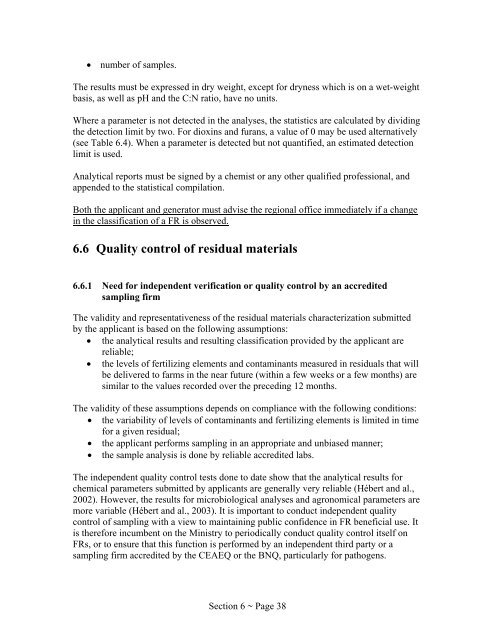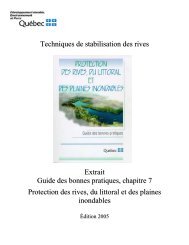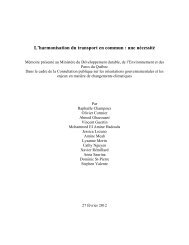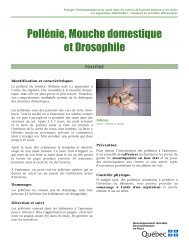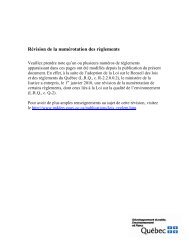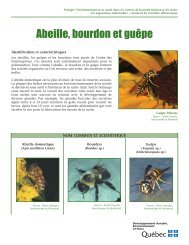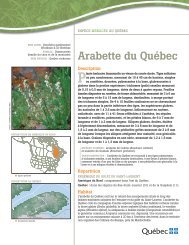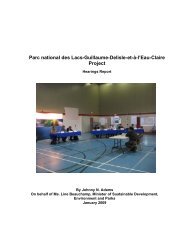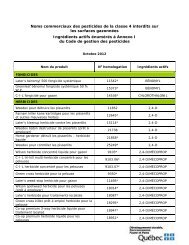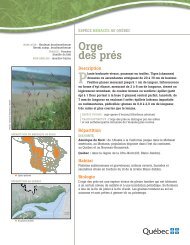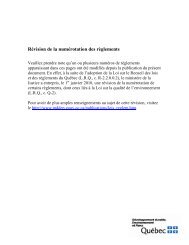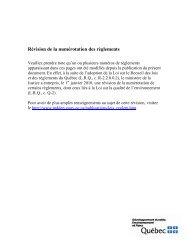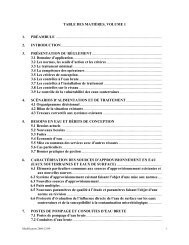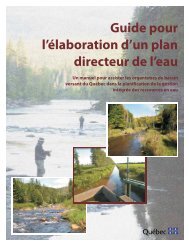Guidelines for the Beneficial Use of Fertilizing Residuals
Guidelines for the Beneficial Use of Fertilizing Residuals
Guidelines for the Beneficial Use of Fertilizing Residuals
Create successful ePaper yourself
Turn your PDF publications into a flip-book with our unique Google optimized e-Paper software.
• number <strong>of</strong> samples.<br />
The results must be expressed in dry weight, except <strong>for</strong> dryness which is on a wet-weight<br />
basis, as well as pH and <strong>the</strong> C:N ratio, have no units.<br />
Where a parameter is not detected in <strong>the</strong> analyses, <strong>the</strong> statistics are calculated by dividing<br />
<strong>the</strong> detection limit by two. For dioxins and furans, a value <strong>of</strong> 0 may be used alternatively<br />
(see Table 6.4). When a parameter is detected but not quantified, an estimated detection<br />
limit is used.<br />
Analytical reports must be signed by a chemist or any o<strong>the</strong>r qualified pr<strong>of</strong>essional, and<br />
appended to <strong>the</strong> statistical compilation.<br />
Both <strong>the</strong> applicant and generator must advise <strong>the</strong> regional <strong>of</strong>fice immediately if a change<br />
in <strong>the</strong> classification <strong>of</strong> a FR is observed.<br />
6.6 Quality control <strong>of</strong> residual materials<br />
6.6.1 Need <strong>for</strong> independent verification or quality control by an accredited<br />
sampling firm<br />
The validity and representativeness <strong>of</strong> <strong>the</strong> residual materials characterization submitted<br />
by <strong>the</strong> applicant is based on <strong>the</strong> following assumptions:<br />
• <strong>the</strong> analytical results and resulting classification provided by <strong>the</strong> applicant are<br />
reliable;<br />
• <strong>the</strong> levels <strong>of</strong> fertilizing elements and contaminants measured in residuals that will<br />
be delivered to farms in <strong>the</strong> near future (within a few weeks or a few months) are<br />
similar to <strong>the</strong> values recorded over <strong>the</strong> preceding 12 months.<br />
The validity <strong>of</strong> <strong>the</strong>se assumptions depends on compliance with <strong>the</strong> following conditions:<br />
• <strong>the</strong> variability <strong>of</strong> levels <strong>of</strong> contaminants and fertilizing elements is limited in time<br />
<strong>for</strong> a given residual;<br />
• <strong>the</strong> applicant per<strong>for</strong>ms sampling in an appropriate and unbiased manner;<br />
• <strong>the</strong> sample analysis is done by reliable accredited labs.<br />
The independent quality control tests done to date show that <strong>the</strong> analytical results <strong>for</strong><br />
chemical parameters submitted by applicants are generally very reliable (Hébert and al.,<br />
2002). However, <strong>the</strong> results <strong>for</strong> microbiological analyses and agronomical parameters are<br />
more variable (Hébert and al., 2003). It is important to conduct independent quality<br />
control <strong>of</strong> sampling with a view to maintaining public confidence in FR beneficial use. It<br />
is <strong>the</strong>re<strong>for</strong>e incumbent on <strong>the</strong> Ministry to periodically conduct quality control itself on<br />
FRs, or to ensure that this function is per<strong>for</strong>med by an independent third party or a<br />
sampling firm accredited by <strong>the</strong> CEAEQ or <strong>the</strong> BNQ, particularly <strong>for</strong> pathogens.<br />
Section 6 ~ Page 38


